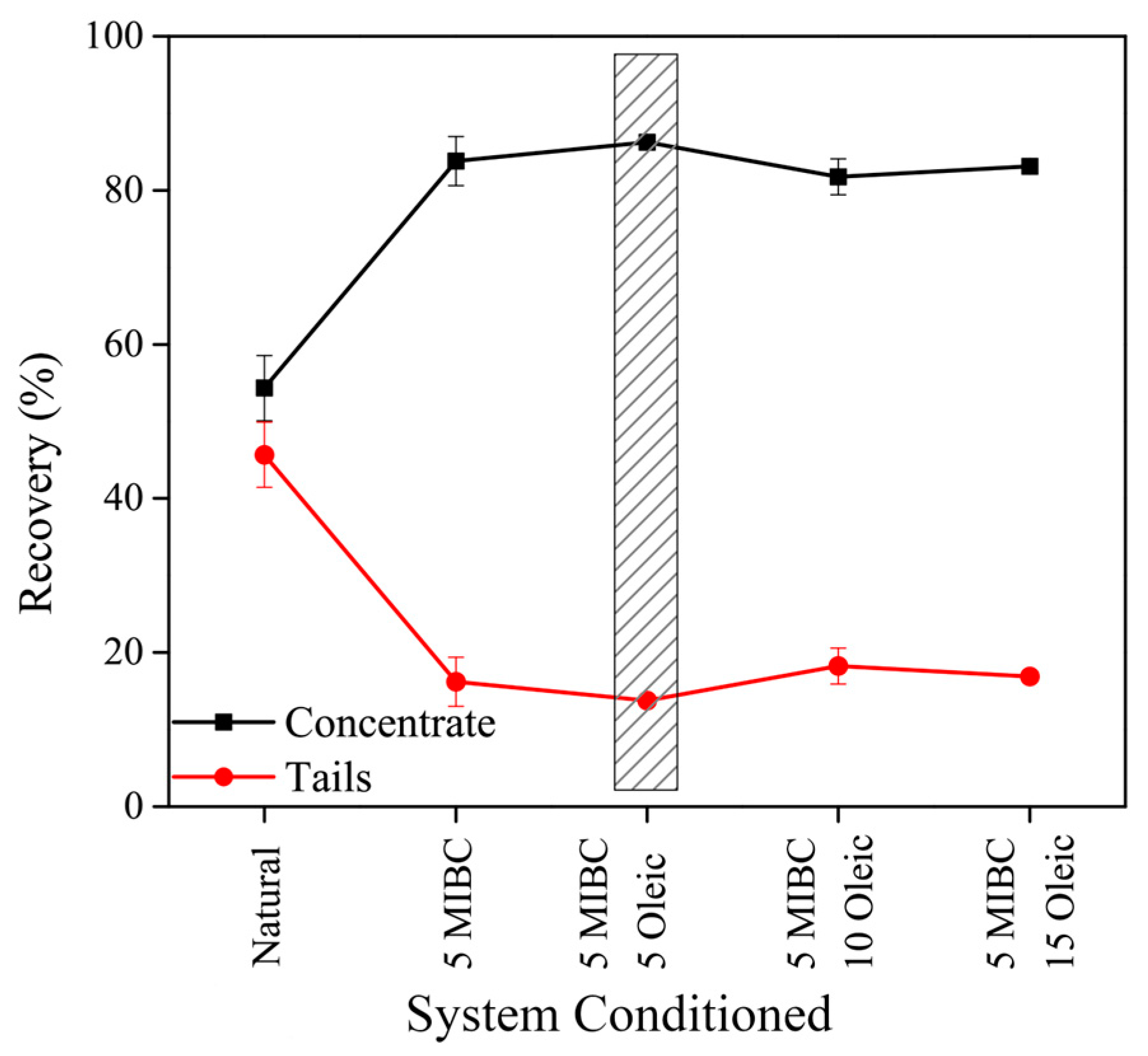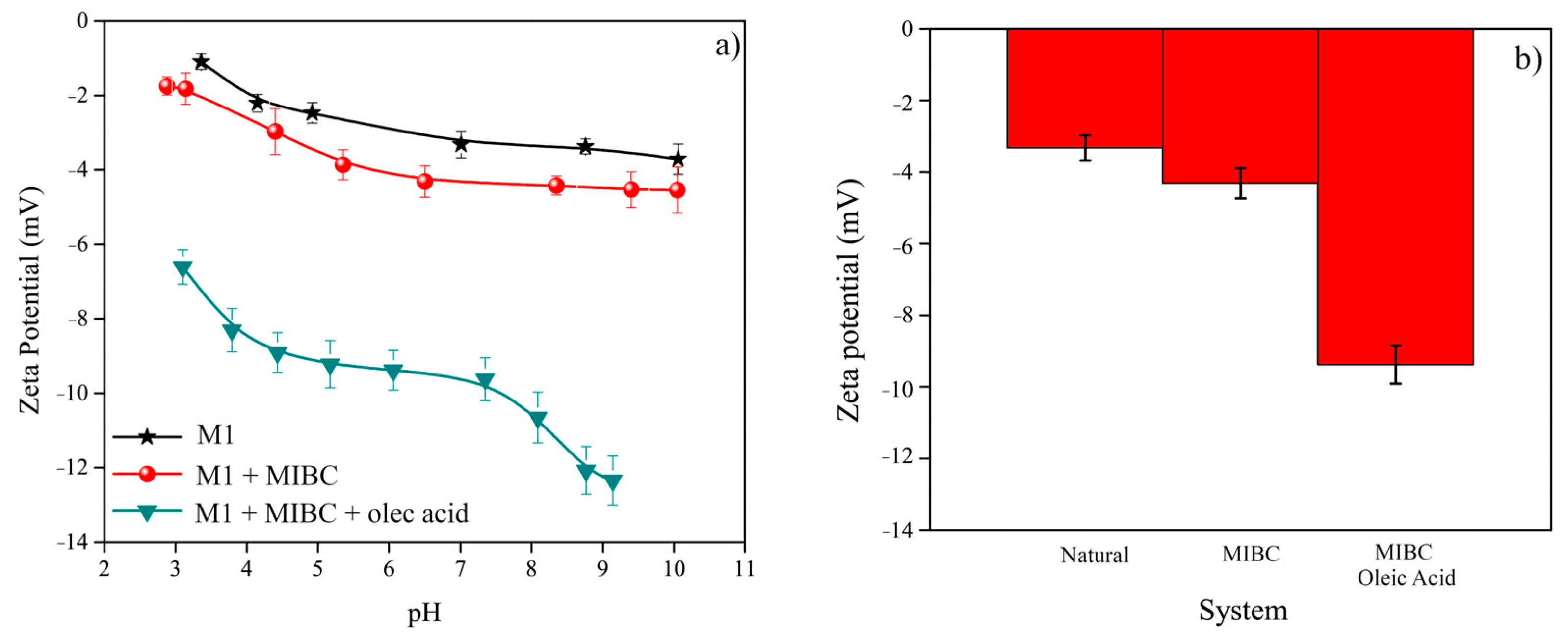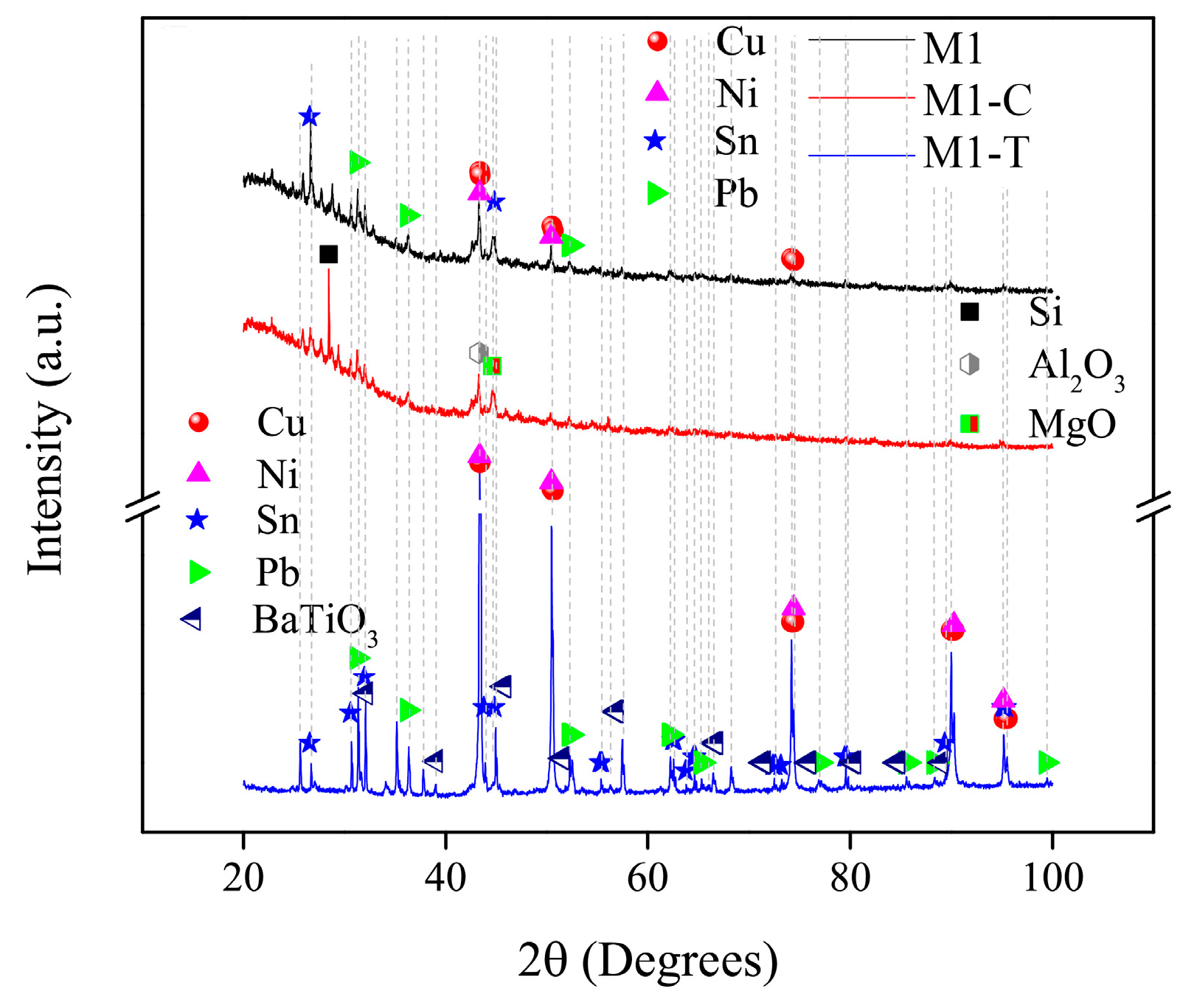Concentration of Silver from Recycling of Fine Powder of Wasted Videogame Printed Circuit Boards through Reverse Froth Flotation and Magnetic Separation Processes
Abstract
:1. Introduction
2. Results and Discussion
2.1. Sample M1 Obtaining
2.2. Silver Concentration Process
2.2.1. Froth Flotation Concentration
2.2.2. Magnetic Concentration
3. Materials and Methods
3.1. Silver Concentration
3.1.1. Sample M1 Obtaining
3.1.2. Silver Concentration Process
3.2. Characterization
4. Conclusions
Author Contributions
Funding
Data Availability Statement
Acknowledgments
Conflicts of Interest
References
- Estrada-Ruiz, R.H.; Flores-Campos, R.; Gámez-Altamirano, H.A.; Velarde-Sánchez, E.J. Separation of the metallic and non-metallic fraction from printed circuit boards employing green technology. J. Hazard. Mater. 2016, 311, 91–99. [Google Scholar] [CrossRef] [PubMed]
- Stuhlpfarrer, P.; Luidold, S.; Antrekowitsch, H. Recycling of waste printed circuit boards with simultaneous enrichment of special metals by using alkaline melts: A green and strategically advantageous solution. J. Hazard. Mater. 2016, 307, 17–25. [Google Scholar] [CrossRef] [PubMed]
- Büyükbay, B.; Ciliz, N.; Goren, G.E.; Mammadov, A. Cleaner production application as a sustainable production strategy, in a Turkish Printed Circuit Board Plant. Resour. Conserv. Recycl. 2010, 54, 744–751. [Google Scholar] [CrossRef]
- Duan, H.; Hou, K.; Li, J.; Zhu, X. Examining the technology acceptance for dismantling of waste printed circuit boards in light of recycling and environmental concerns. J. Environ. Manag. 2011, 92, 392–399. [Google Scholar] [CrossRef] [PubMed]
- Yamane, L.H.; De Moraes, V.T.; Crocce, D.; Espinosa, R.; Alberto, J.; Tenório, S. Recycling of WEEE: Characterization of spent printed circuit boards from mobile phones and computers. Waste Manag. 2011, 31, 2553–2558. [Google Scholar] [CrossRef]
- Guo, C.; Wang, H.; Liang, W.; Fu, J.; Yi, X. Liberation characteristic and physical separation of printed circuit board (PCB). Waste Manag. 2011, 31, 2161–2166. [Google Scholar] [CrossRef]
- Panda, R.; Mishra, S.; Kishore, K.; Bhaskar, T. A closed loop recycling strategy for sustainable recovery of group 11 metals (Cu, Au, and Ag) from waste PCBs: An amalgamation of low-temperature NH4Cl roasting, HCl leaching and cementation. Sustain. Mater. Technol. 2023, 37, e00652. [Google Scholar] [CrossRef]
- Islam, M.T.; Iyer-Raniga, U. Life cycle assessment of e-waste management system in Australia: Case of waste printed circuit board (PCB). J. Clean. Prod. 2023, 418, 138082. [Google Scholar] [CrossRef]
- Das, S.K.; Ellamparuthy, G.; Kundu, T.; Ghosh, M.K.; Angadi, S.I. Critical analysis of metallic and non-metallic fractions in the flotation of waste printed circuit boards. Powder Technol. 2021, 389, 450–459. [Google Scholar] [CrossRef]
- Ali, L.; Mousa, H.A.; Al-Harahsheh, M.; Al-Zuhair, S.; Abu-Jdayil, B.; Al-Marzouqi, M.; Altarawneh, M. Removal of Bromine from the non-metallic fraction in printed circuit board via its Co-pyrolysis with alumina. Waste Manag. 2022, 137, 283–293. [Google Scholar] [CrossRef]
- Kumar, V.; Chun Lee, J.; Jeong, J.; Jha, M.K.; Kim, B.S.; Singh, R. Recycling of printed circuit boards (PCBs) to generate enriched rare metal concentrate. J. Ind. Eng. Chem. 2015, 21, 805–813. [Google Scholar] [CrossRef]
- Liu, R.; Ma, S.; Li, G.; Yu, Y.; An, T. Comparing pollution patterns and human exposure to atmospheric PBDEs and PCBs emitted from different e-waste dismantling processes. J. Hazard. Mater. 2019, 369, 142–149. [Google Scholar] [CrossRef] [PubMed]
- Cucchiella, F.; D’Adamo, I.; Lenny Koh, S.C.; Rosa, P. A profitability assessment of European recycling processes treating printed circuit boards from waste electrical and electronic equipments. Renew. Sustain. Energy Rev. 2016, 64, 749–760. [Google Scholar] [CrossRef]
- Kelly, E.; Spottiswood, D. Introduction to Mineral Processing; John Wiley & Sons Inc.: New York, NY, USA, 1982. [Google Scholar]
- Zhu, P.; Chen, Y.; Wang, L.Y.; Zhou, M.; Zhou, J. The separation of waste printed circuit board by dissolving bromine epoxy resin using organic solvent. Waste Manag. 2013, 33, 484–488. [Google Scholar] [CrossRef]
- Zhu, P.; Chen, Y.; Wang, L.Y.; Qian, G.Y.; Zhou, M.; Zhou, J. A new technology for separation and recovery of materials from waste printed circuit boards by dissolving bromine epoxy resins using ionic liquid. J. Hazard. Mater. 2012, 239–240, 270–278. [Google Scholar] [CrossRef]
- Magoda, K.; Nomngongo, P.N.; Mekuto, L. Two-Step Bio-Dissolution of Metals from Printed Circuit Boards Using Acidophilic Iron- and Sulfur-Oxidizing Mesophiles. Recycling 2024, 9, 6. [Google Scholar] [CrossRef]
- Bachér, J.; Rintala, L.; Horttanainen, M. The effect of crusher type on printed circuit board assemblies’ liberation and dust generation from waste mobile phones. Miner. Eng. 2022, 185, 107674. [Google Scholar] [CrossRef]
- Fuerstenau, M.C.; Jameson, G.J.; Yoon, R.H. Froth Flotation: A Century of Innovation; SME: Englewood, CO, USA, 2007. [Google Scholar]
- Flores-Campos, R.; Estrada-Ruiz, R.H.; Velarde-Sánchez, E.J. Study of the physicochemical effects on the separation of the non-metallic fraction from printed circuit boards by inverse flotation. Waste Manag. 2017, 69, 400–406. [Google Scholar] [CrossRef]
- Yukselen-Aksoy, Y.; Kaya, A. A study of factors affecting on the zeta potential of kaolinite and quartz powder. Environ. Earth Sci. 2011, 62, 697–705. [Google Scholar] [CrossRef]
- Kim, J.; Nason, J.A.; Lawler, D.F. Zeta potential distributions in particle treatment processes. J. Water Supply Res. Technol. 2006, 55, 461–470. [Google Scholar] [CrossRef]
- Olson, E. Zeta Potential and Colloid Chemistry. J. GXP Compliance 2012, 16, 81–96. [Google Scholar]
- Fan, G.; Wang, L.; Cao, Y.; Li, C. Collecting Agent–Mineral Interactions in the Reverse Flotation of Iron Ore: A Brief Review. Minerals 2020, 10, 681. [Google Scholar] [CrossRef]
- Nguyen, K.T.; Shahir, A.A.; Nguyen, A.V. Probing the Molecular Orientation of Methyl Isobutyl Carbinol at the Air–Water Interface. Surfactants Deterg. 2017, 20, 969–976. [Google Scholar] [CrossRef]
- Phan, C.M.; Nakahara, H.; Shibata, O.; Moroi, Y.; Le, T.N.; Ang, H.M. Surface Potential of Methyl Isobutyl Carbinol Adsorption Layer at the Air/Water Interface Surface potential of methyl isobutyl carbinol adsorption layer at the air/water interface. J. Phys. Chem. B 2012, 116, 980–986. [Google Scholar] [CrossRef]
- Pattanaik, A.; Venugopal, A. Role of Surfactants in Mineral Processing: An Overview. In Surfactants and Detergents; Dutta, A.K., Ed.; IntechOpen: London, UK, 2019; Volume 1, pp. 1–17. [Google Scholar] [CrossRef]
- Cook, B.K.; Gibson, C.E. A Review of Fatty Acid Collectors: Implications for Spodumene Flotation. Minerals 2023, 13, 212. [Google Scholar] [CrossRef]
- Yu, F.; Wang, Y.; Zhang, L.; Zhu, G. Role of oleic acid ionic–molecular complexes in the flotation of spodumene. Miner. Eng. 2015, 71, 7–12. [Google Scholar] [CrossRef]
- Bhadani, A.; Iwabata, K.; Sakai, K.; Koura, S.; Sakai, H.; Abe, M. Sustainable oleic and stearic acid based biodegradable surfactants. RSC Adv. 2017, 7, 10433–10442. [Google Scholar] [CrossRef]
- Avner, S.H.; Haen, J.L.E.; Mejía, G.B. Introducción a la Metalurgia Física; McGraw-Hill: México, México, 1979. [Google Scholar]
- Jamil, M.S.; Saputro, K.E.; Noviyanto, A.; Widayatno, W.B.; Wismogroho, A.S.; Amal, M.I.; Rochman, N.T.; Nishimura, T. Dense and fine-grained barium titanate prepared by spark plasma sintering. J. Phys. Conf. Ser. 2019, 1191, 012039. [Google Scholar] [CrossRef]
- Gale, W.F. Smithells Metals Reference Book, 8th ed.; Elsevier/ASM International: Boston, MA, USA, 2004. [Google Scholar]
- Yoo, J.M.; Jeong, J.; Yoo, K.; Lee, J.; Kim, W. Enrichment of the metallic components from waste printed circuit boards by a mechanical separation process using a stamp mill. Waste Manag. 2009, 29, 1132–1137. [Google Scholar] [CrossRef]
- Flores-Campos, R.; Deaquino-Lara, R.; Rodríguez-Reyes, M.; Martínez-Sánchez, R.; Estrada-Ruiz, R.H. The Use of Nonmetallic Fraction Particles with the Double Purpose of Increasing the Mechanical Properties of Low-Density Polyethylene Composite and Reducing the Pollution Associated with the Recycling of Metals from E-Waste. Recycling 2024, 9, 56. [Google Scholar] [CrossRef]
- Estrada-Ruiz, R.H.; Flores-Campos, R. E-Waste. Mendeley Data, v2. 2022. Available online: https://data.mendeley.com/datasets/4wtbk3yk4f/2 (accessed on 1 April 2022). [CrossRef]







| Product/Sample | Natural (g/cm3) | 5 MIBC (g/cm3) | 5MIBC + 5OA (g/cm3) | 5MIBC + 10OA (g/cm3) | 5MIBC + 15OA (g/cm3) |
|---|---|---|---|---|---|
| Feed/M1 | 2.46 ± 0.20 | 2.35 ± 0.19 | 2.12 ± 0.15 | 2.28 ± 0.14 | 2.23 ± 0.20 |
| Concentrate/M1-C | 2.24 ± 0.39 | 2.06 ± 0.21 | 1.93 ± 0.13 | 2.21 ± 0.22 | 2.20 ± 0.31 |
| Tails/M1-T | 4.16 ± 0.10 | 4.39 ± 0.36 | 4.08 ± 0.37 | 4.19 ± 0.29 | 4.11 ± 0.12 |
Disclaimer/Publisher’s Note: The statements, opinions and data contained in all publications are solely those of the individual author(s) and contributor(s) and not of MDPI and/or the editor(s). MDPI and/or the editor(s) disclaim responsibility for any injury to people or property resulting from any ideas, methods, instructions or products referred to in the content. |
© 2024 by the authors. Licensee MDPI, Basel, Switzerland. This article is an open access article distributed under the terms and conditions of the Creative Commons Attribution (CC BY) license (https://creativecommons.org/licenses/by/4.0/).
Share and Cite
Flores-Campos, R.; Estrada-Ruiz, R.H.; Rodríguez-Reyes, M.; Martínez-Carrillo, D.; Martínez-Luévanos, A. Concentration of Silver from Recycling of Fine Powder of Wasted Videogame Printed Circuit Boards through Reverse Froth Flotation and Magnetic Separation Processes. Recycling 2024, 9, 60. https://doi.org/10.3390/recycling9040060
Flores-Campos R, Estrada-Ruiz RH, Rodríguez-Reyes M, Martínez-Carrillo D, Martínez-Luévanos A. Concentration of Silver from Recycling of Fine Powder of Wasted Videogame Printed Circuit Boards through Reverse Froth Flotation and Magnetic Separation Processes. Recycling. 2024; 9(4):60. https://doi.org/10.3390/recycling9040060
Chicago/Turabian StyleFlores-Campos, Rubén, Rosa Hilda Estrada-Ruiz, Mario Rodríguez-Reyes, Diego Martínez-Carrillo, and Antonia Martínez-Luévanos. 2024. "Concentration of Silver from Recycling of Fine Powder of Wasted Videogame Printed Circuit Boards through Reverse Froth Flotation and Magnetic Separation Processes" Recycling 9, no. 4: 60. https://doi.org/10.3390/recycling9040060






